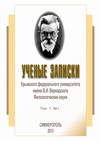The article is devoted to the analysis of individual elements of the strong position of the poetic text, in which representatives of the concept “Garden” appear in the poetry of B. A. Akhmadulina. Based on the material of the poems of B. A. Akhmadulina, the components of poetic expression are examined, represented by such strong text positions as the first and final verse, rhyming elements, and repetition. Such an approach, on the one hand, makes it possible to reveal the essence of the functions of the components of the text, to consider its composition as the embodiment of the author’s intentions, on the other hand, to offer a system of methodological techniques that allow the recipient to “decipher” the author’s text and correctly interpret its meaning. The article uses both methods of modern text theory (stylistic analysis of a literary text, methods of highlighting strong positions of the text) and methods of communicative stylistics. As a result of a comprehensive textual analysis, it was revealed that the use of a specific lexeme in strong positions serves as a marker of the poet’s idiostyle and his picture of the world, and also conveys important semantic information for the reader, necessary for adequate decoding of the author’s intention.
concept, strong position of the text, individual author’s picture of the world, techniques of promotion, first verse, final verse, rhyming position, repetition.
1. Arnol'd I. V. Stilistika. Sovremennyy angliyskiy yazyk: uchebnik dlya vuzov. – M.: Flinta, 2010. – 384 s.
2. Arnol'd I. V. Znachenie sil'noy pozicii dlya interpretacii hudozhestvennogo teksta // Inostrannye yazyki v shkole. – 1978. – № 4. – S. 23–31.
3. Babenko L. G., Kazarin Yu. V. Lingvisticheskiy analiz hudozhestvennogo teksta. Teoriya i praktika. – M.: Flinta, 2006. – 496 s.
4. Bolotnova N. S. Filologicheskiy analiz teksta: uch. posobie. – M.: Flinta: Nauka, 2007. – 520 s.
5. Bolotnova N. S. Filologicheskiy analiz teksta: ucheb. posobie. – M.: Flinta: Nauka, 2009. – 520 s.
6. Gasparov M. L. Metr i smysl: K semantike russkogo trehstopnogo horeya. – M., 1976. – Seriya literatury i yazyka. – T. 35. – № 4. – S. 357–366.
7. Gasparov M.L. Lingvistika stiha // Izvestiya AN SSSR. Ser. lit. i yazyka. – T. 53. – 1994. – № 6. – S. 28–36.
8. Gasparov M.L. Rifma Brodskogo // Izbrannye stat'i. – M.: NLO, 1995. – S. 83–92.
9. Goncharov B.P. O rifme Mayakovskogo // Filol. nauki. – 1972. – № 2. – S. 3–14.
10. Doneckih L. I., Nypadymka A. S. Strukturnye tipy kompozicionnoy organizacii smyslovogo prostranstva slovoobraza «Bol'» v poetike Yulii Druninoy // Vestnik Udmurtskogo universiteta.
11. Zhirmunskiy V. M. Teoriya stiha. – Leningrad: Sovetskiy pisatel', 1975. – 664 s.
12. Zabashta R. V. Pozicionnoe videnie struktur poeticheskogo teksta kak instrument interpretacii (na materiale stihotvoreniy Iosifa Brodskogo) // Voprosy obrazovaniya i psihologii
13. Kazarin Yu. V. Poeticheskiy tekst kak sistema. – Ekaterinburg: Izd-vo Ural, un-ta, 1999. – 260 s.
14. Kozhevnikova N. A. Konstrukcii perechisleniya // Poeticheskaya grammatika. – M.: Azbukovnik, 2005. – S. 298–327.
15. Kochetkov D. A. Rifma D. L. Andreeva v lingvisticheskom aspekte: Dis. … kand. filolog. nauk: 10.02.01. – Cherepovec, 2000. – 379 s.
16. Larin B. A. Estetika slova i yazyka pisatelya // Izbrannye stat'i. – Leningrad: GIHL, 1974. – 285 s.
17. Matveeva T. V. Polnyy slovar' lingvisticheskih terminov. – Rostov-na-Donu: Feniks, 2010. – S. 118–119.
18. Mihaylova M. S. Koncept sada i metafora cvetochnogo vremeni v knige Belly Ahmadulinoy «Sad» // Kul'tura i tekst: V 3 t. – SPb. – Samara – Barnaul: Izd-vo BGPU, 2005. – T. 1. – S. 192–197.
19. Patroeva N. V. Nachal'naya stroka kak sil'naya poziciya liricheskogo teksta (na materiale poezii E. A. Baratynskogo) // Pushkinskie chteniya. – 2013. – № XVIII. – S. 199-204.
20. Samoylov D. Kniga o russkoy rifme. – Moskva: Vremya, 2005. – 400 s.
21. Strel'cova E. V. Sil'nye pozicii hudozhestvennogo teksta: nachalo i konec proizvedeniya (na materiale proizvedeniy R. Dalya) // Vestnik VUiT. – 2018. – № 1. – S. 31–36.
22. Uspenskiy B. A. Poetika kompozicii // Semiotika iskusstva. – M.: Iskusstvo, 1995. – S. 7–218.
23. Ushakov D. N. Tolkovyy slovar' sovremennogo russkogo yazyka. – M.: Adelant, 2014. – 800 c.
24. Homyakova E. S. Sad kak fonovyy risunok poeticheskogo teksta // Vestnik Voronezhskogo gosudarstvennogo universiteta. Seriya: filologiya. Zhurnalistika. – № 4. – 2024. – S. 85–87.
25. Chernuhina I. Ya. Obschie osobennosti poeticheskogo teksta (lirika). – Voronezh: Izd-vo Voronezh. un-ta, 1987. – 157 s.
26. Chumak-Zhun' I. I. K voprosu ob evristicheskom rakurse poeticheskogo diskursa B. L. Pasternaka // Russkiy yazyk v polikul'turnom mire: Sbornik nauchnyh statey VI Mezhdunarodnogo simpoziuma.
27. Epshteyn M. N. «Priroda, mir, taynik vselennoy…». Sistema peyzazhnyh obrazov v russkoy poezii. – Moskva: Vysshaya shkola, 1990. – 306 s.
28. Kcvecses Zoltan. A new look at metaphorical creativity in cognitive linguistics // Cognitive Linguistics. – 2010. – № 21–4. – P. 663–697.





